MENU
The Electronic Scholarly Publishing Project: Providing access to classic scientific papers and other scholarly materials, since 1993. More About: ESP | OUR CONTENT | THIS WEBSITE | WHAT'S NEW | WHAT'S HOT
Comparative Timelines
The ESP Timeline (one of the site's most popular features) has been completely updated to allow the user to select (using the timeline controls above each column) different topics for the left and right sides of the display.
Select:
New Left Column
New Left Column
Dates
Decade
New Right Column
New Right Column
(no entry for this year)
1632
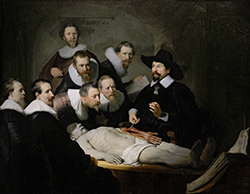 Painting by Rembrandt: The Anatomy Lesson of Dr. Nicolaes Tulp shows Dr. Tulp explaining the musculature of the arm to medical professionals. Some of the spectators are various doctors who paid commissions to be included in the painting. The painting is signed in the top-left hand corner Rembrandt. f[ecit] 1632. This may be the first instance of Rembrandt signing a painting with his forename (in its original form) as opposed to the monogramme RHL (Rembrandt Harmenszoon of Leiden), and is thus a sign of his growing artistic confidence.
Painting by Rembrandt: The Anatomy Lesson of Dr. Nicolaes Tulp shows Dr. Tulp explaining the musculature of the arm to medical professionals. Some of the spectators are various doctors who paid commissions to be included in the painting. The painting is signed in the top-left hand corner Rembrandt. f[ecit] 1632. This may be the first instance of Rembrandt signing a painting with his forename (in its original form) as opposed to the monogramme RHL (Rembrandt Harmenszoon of Leiden), and is thus a sign of his growing artistic confidence.
Charles I of England grants a charter to Cecilius Calvert, second Lord Baltimore, for colony in Maryland
 Galileo Galilei first describes the Principle of Relativity, the idea that the fundamental laws of physics are the same in all inertial frames and that, purely by observing the outcome of mechanical experiments, one cannot distinguish a state of rest from a state of constant velocity.
Galileo Galilei first describes the Principle of Relativity, the idea that the fundamental laws of physics are the same in all inertial frames and that, purely by observing the outcome of mechanical experiments, one cannot distinguish a state of rest from a state of constant velocity.
(no entry for this year)
1633
 Under compulsion, Galileo rejects the Copernican system.
Under compulsion, Galileo rejects the Copernican system.
 The French philosopher Ren Descartes outlines a model of a static, infinite universe made up of tiny corpuscles of matter, a viewpoint not dissimilar to ancient Greek atomism. Descartes universe shares many elements of Sir Isaac Newton s later model, although Descartes vacuum of space is not empty but composed of huge swirling whirlpools of ethereal or fine matter, producing what would later be called gravitational effects.
The French philosopher Ren Descartes outlines a model of a static, infinite universe made up of tiny corpuscles of matter, a viewpoint not dissimilar to ancient Greek atomism. Descartes universe shares many elements of Sir Isaac Newton s later model, although Descartes vacuum of space is not empty but composed of huge swirling whirlpools of ethereal or fine matter, producing what would later be called gravitational effects.
(no entry for this year)
1634
(no entry for this year)
(no entry for this year)
1635
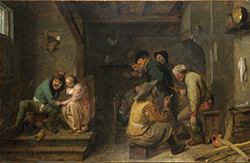 Painting by Adriaen Brouwer: Tavern Scene. Brouwer left a small body of work amounting to about 60 works. Just a few of his works are signed, while none is dated. As Brouwer was widely copied, imitated and followed in his time, attributions of work to Brouwer are sometimes uncertain or contested. For instance, the The smoker (Louvre) showing a man exhaling smoke while holding a bottle of liquor was attributed for a long time to Brouwer, but is now given to Brouwer's follower and, possibly, pupil Joos van Craesbeeck. The principal subject matter of Brouwer are genre scenes with peasants, soldiers and other 'lower class' individuals engaging in drinking, smoking, card or dice playing, fights etc. often set in taverns or rural settings. Brouwer also contributed to the development of the genre of tronies, i.e. head or facial studies, which investigate varieties of expression.
Painting by Adriaen Brouwer: Tavern Scene. Brouwer left a small body of work amounting to about 60 works. Just a few of his works are signed, while none is dated. As Brouwer was widely copied, imitated and followed in his time, attributions of work to Brouwer are sometimes uncertain or contested. For instance, the The smoker (Louvre) showing a man exhaling smoke while holding a bottle of liquor was attributed for a long time to Brouwer, but is now given to Brouwer's follower and, possibly, pupil Joos van Craesbeeck. The principal subject matter of Brouwer are genre scenes with peasants, soldiers and other 'lower class' individuals engaging in drinking, smoking, card or dice playing, fights etc. often set in taverns or rural settings. Brouwer also contributed to the development of the genre of tronies, i.e. head or facial studies, which investigate varieties of expression.
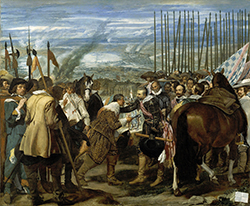 Painting by Diego Velázquez: The Surrender of Breda was inspired by Velázquez's visit to Italy with Ambrogio Spinola, the Genoese general who conquered Breda on June 5, 1625. It is considered one of Velázquez's best works. Jan Morris has called it "one of the most Spanish of all pictures".
Painting by Diego Velázquez: The Surrender of Breda was inspired by Velázquez's visit to Italy with Ambrogio Spinola, the Genoese general who conquered Breda on June 5, 1625. It is considered one of Velázquez's best works. Jan Morris has called it "one of the most Spanish of all pictures".
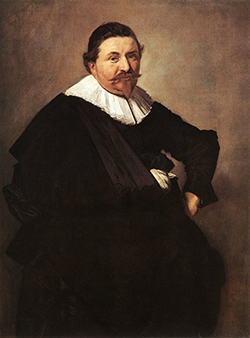 Painting by Frans Hals: Lucas de Clercq, a Dutch cloth merchant known today for his and his wife's pendant marriage portraits painted by Frans Hals.
Painting by Frans Hals: Lucas de Clercq, a Dutch cloth merchant known today for his and his wife's pendant marriage portraits painted by Frans Hals.
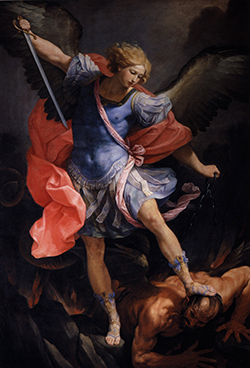 Painting by Guido Reni: The Archangel Michael vanquishing Satan
Painting by Guido Reni: The Archangel Michael vanquishing Satan
(no entry for this year)
1636
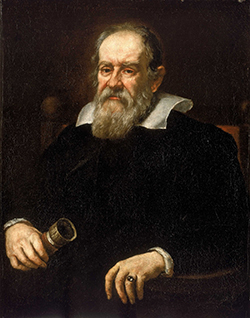 Painting by Justus Sustermans: Portrait of Galileo Galilei. Justus Sustermans was a Flemish painter working in the Baroque style. He was born in Antwerp and died in Florence. Sustermans is chiefly notable for his portraits of members of the Medici family as he was their court painter. His work can be found in both the Palatina Gallery and the Uffizi Gallery in Florence, and in many other galleries around the globe. During his lifetime he was f ted as the finest portrait painter in Italy.
Painting by Justus Sustermans: Portrait of Galileo Galilei. Justus Sustermans was a Flemish painter working in the Baroque style. He was born in Antwerp and died in Florence. Sustermans is chiefly notable for his portraits of members of the Medici family as he was their court painter. His work can be found in both the Palatina Gallery and the Uffizi Gallery in Florence, and in many other galleries around the globe. During his lifetime he was f ted as the finest portrait painter in Italy.
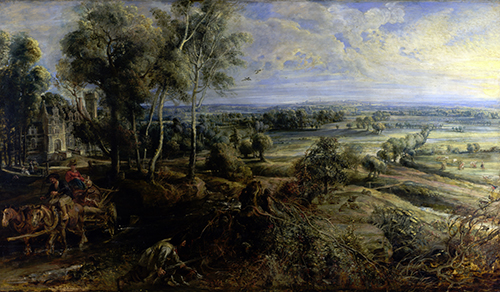 Painting by Peter Paul Rubens: A View of Het Steen in the Early Morning is a landscape painting now in the National Gallery in London. A rare example of a work painted for the artist's own pleasure rather than for a commission, it shows a view of the Het Steen estate near Brussels, which he had acquired in 1635, set in an early-morning autumn landscape. He had initially intended a much smaller painting focussing on the house, using three small oak planks, probably spares from his studio as the concept developed, seventeen more panels were added. It has influenced artists including John Constable, during his period working for Sir George Beaumont, who then owned the painting and later donated it to the National Gallery in 1823. The painting features the first convincing depiction of a mackerel sky.
Painting by Peter Paul Rubens: A View of Het Steen in the Early Morning is a landscape painting now in the National Gallery in London. A rare example of a work painted for the artist's own pleasure rather than for a commission, it shows a view of the Het Steen estate near Brussels, which he had acquired in 1635, set in an early-morning autumn landscape. He had initially intended a much smaller painting focussing on the house, using three small oak planks, probably spares from his studio as the concept developed, seventeen more panels were added. It has influenced artists including John Constable, during his period working for Sir George Beaumont, who then owned the painting and later donated it to the National Gallery in 1823. The painting features the first convincing depiction of a mackerel sky.
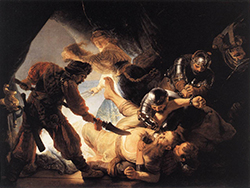 Painting by Rembrandt: The Blinding of Samson is now in the St del. The painting is the first of its kind in pictorial tradition. No other artist at the time had painted this specific narrative moment. This painting was a gift to the House of Orange, Rembrandt's current patron of a few commissioned paintings.
Painting by Rembrandt: The Blinding of Samson is now in the St del. The painting is the first of its kind in pictorial tradition. No other artist at the time had painted this specific narrative moment. This painting was a gift to the House of Orange, Rembrandt's current patron of a few commissioned paintings.
Harvard College is established.
Colonial North America's slave trade begins when the first American slave carrier, Desire, is built and launched in Massachusetts.
Harvard University is founded in Cambridge, Massachusetts.
(no entry for this year)
1637
Francesco Stelluti publishes a summary of research on fossil wood conducted by himself and fellow Lincean Academy member Federico Cesi. Though resulting from meticulous research, the work reaches the wrong conclusion, describing the origin of fossil wood as inorganic.
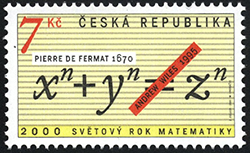 Pierre de Fermat formulates his so-called Last Theorem, unsolved until 1995. In number theory, Fermat's Last Theorem (sometimes called Fermat's conjecture, especially in older texts) states that no three positive integers a, b, and c satisfy the equation an + bn = cn for any integer value of n greater than 2. The cases n = 1 and n = 2 have been known to have infinitely many solutions since antiquity. This theorem was first conjectured by Pierre de Fermat in 1637 in the margin of a copy of Arithmetica where he claimed he had a proof that was too large to fit in the margin.
Pierre de Fermat formulates his so-called Last Theorem, unsolved until 1995. In number theory, Fermat's Last Theorem (sometimes called Fermat's conjecture, especially in older texts) states that no three positive integers a, b, and c satisfy the equation an + bn = cn for any integer value of n greater than 2. The cases n = 1 and n = 2 have been known to have infinitely many solutions since antiquity. This theorem was first conjectured by Pierre de Fermat in 1637 in the margin of a copy of Arithmetica where he claimed he had a proof that was too large to fit in the margin.
(no entry for this year)
1638
 Galileo Galilei demonstrates that unequal weights would fall with the same finite speed in a vacuum, and that their time of descent is independent of their mass. Thus, freely falling bodies, heavy or light, have the same constant acceleration, due to the force of gravity.
Galileo Galilei demonstrates that unequal weights would fall with the same finite speed in a vacuum, and that their time of descent is independent of their mass. Thus, freely falling bodies, heavy or light, have the same constant acceleration, due to the force of gravity.
(no entry for this year)
1639
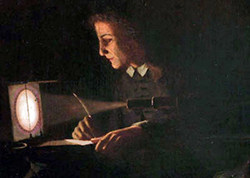 Jeremiah Horrox observes the first transit of Venus. Horrox (or Horrocks) was an English astronomer. He was the first person to demonstrate that the Moon moved around the Earth in an elliptical orbit; and he was the only person to predict the transit of Venus of 1639, an event which he and his friend William Crabtree were the only two people to observe and record.
Jeremiah Horrox observes the first transit of Venus. Horrox (or Horrocks) was an English astronomer. He was the first person to demonstrate that the Moon moved around the Earth in an elliptical orbit; and he was the only person to predict the transit of Venus of 1639, an event which he and his friend William Crabtree were the only two people to observe and record.
ESP Quick Facts
ESP Origins
In the early 1990's, Robert Robbins was a faculty member at Johns Hopkins, where he directed the informatics core of GDB — the human gene-mapping database of the international human genome project. To share papers with colleagues around the world, he set up a small paper-sharing section on his personal web page. This small project evolved into The Electronic Scholarly Publishing Project.
ESP Support
In 1995, Robbins became the VP/IT of the Fred Hutchinson Cancer Research Center in Seattle, WA. Soon after arriving in Seattle, Robbins secured funding, through the ELSI component of the US Human Genome Project, to create the original ESP.ORG web site, with the formal goal of providing free, world-wide access to the literature of classical genetics.
ESP Rationale
Although the methods of molecular biology can seem almost magical to the uninitiated, the original techniques of classical genetics are readily appreciated by one and all: cross individuals that differ in some inherited trait, collect all of the progeny, score their attributes, and propose mechanisms to explain the patterns of inheritance observed.
ESP Goal
In reading the early works of classical genetics, one is drawn, almost inexorably, into ever more complex models, until molecular explanations begin to seem both necessary and natural. At that point, the tools for understanding genome research are at hand. Assisting readers reach this point was the original goal of The Electronic Scholarly Publishing Project.
ESP Usage
Usage of the site grew rapidly and has remained high. Faculty began to use the site for their assigned readings. Other on-line publishers, ranging from The New York Times to Nature referenced ESP materials in their own publications. Nobel laureates (e.g., Joshua Lederberg) regularly used the site and even wrote to suggest changes and improvements.
ESP Content
When the site began, no journals were making their early content available in digital format. As a result, ESP was obliged to digitize classic literature before it could be made available. For many important papers — such as Mendel's original paper or the first genetic map — ESP had to produce entirely new typeset versions of the works, if they were to be available in a high-quality format.
ESP Help
Early support from the DOE component of the Human Genome Project was critically important for getting the ESP project on a firm foundation. Since that funding ended (nearly 20 years ago), the project has been operated as a purely volunteer effort. Anyone wishing to assist in these efforts should send an email to Robbins.
ESP Plans
With the development of methods for adding typeset side notes to PDF files, the ESP project now plans to add annotated versions of some classical papers to its holdings. We also plan to add new reference and pedagogical material. We have already started providing regularly updated, comprehensive bibliographies to the ESP.ORG site.
ESP Picks from Around the Web (updated 06 MAR 2017 )
Old Science

Weird Science

Treating Disease with Fecal Transplantation
Fossils of miniature humans (hobbits) discovered in Indonesia

Dinosaur tail, complete with feathers, found preserved in amber.
Astronomy

Mysterious fast radio burst (FRB) detected in the distant universe.